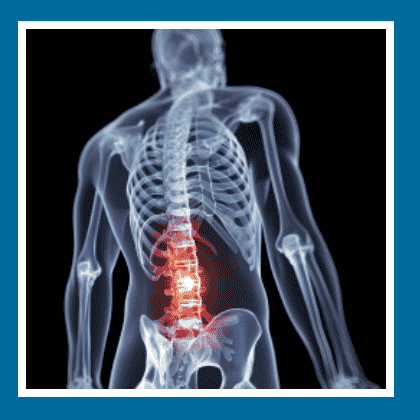 Chronic lower back pain is one of the most common complaints of the patients referred to Commonwealth Pain Specialists. This plaguing condition can affect every part of your life from getting out of bed in the morning, to driving your car to even conducting basic hygiene. The pain and discomfort patients experience can be very frustrating. Commonwealth Pain Specialists’ team of physicians understands this frustration and will do everything we can to identify the cause of the pain and treat it at its source.
Chronic lower back pain is one of the most common complaints of the patients referred to Commonwealth Pain Specialists. This plaguing condition can affect every part of your life from getting out of bed in the morning, to driving your car to even conducting basic hygiene. The pain and discomfort patients experience can be very frustrating. Commonwealth Pain Specialists’ team of physicians understands this frustration and will do everything we can to identify the cause of the pain and treat it at its source.
Diagnosis
The complaint of lower back pain is not, in itself, a diagnosis. Your doctor will first need to check a few blocks before a diagnosis can be achieved. A full patient medical history and family history will need to be completed to identify risk factors for any conditions that could provoke symptoms. A physical exam will also be conducted by your provider to observe your anatomy and assess range of motion and gait. These findings will be paired with diagnostic images, such as x-rays of the lower back, hips and pelvis, as well as a CT scan or MRI of the same areas which can help identify fractures, herniations, dislocations or swelling.
Treatment
Treatment will vary depending on the cause of the pain. However, for most patients pain relief and mobility can be achieved through a combination of non-invasive or minimally invasive means.
- While everyone already knows this, some people have to hear it: rest is key to recovery! Over use of already irritated tissue will result in increased inflammation which will cause more pain.
- Ice pack and heat therapy can be very effective at reducing inflammation and relieving discomfort in the lower back. Patients can alternate ice packs and heating pads at home while comfortably seated.
- Physical therapists may also offer more advanced ice and heat therapies through specialized equipment in their clinics. In general, physical therapy is a great way for patients to learn good body mechanics and strengthen their lower backs to prevent further injuries.
- Medications are also very effective at relieving or reducing lower back pain. Muscle relaxers reduce the tension from tight muscles which may be lending to the decreased mobility and irritation of tissue. Anti-inflammatories, which include non-steroidal analgesics (NSAIDS) such as naproxen or ibuprofen, can reduce painful swelling and irritation.
- Steroid injection via fluoroscopy is very effective at reducing, if not entirely eliminating, lower back pain. Fluoroscopy is a real-time three dimensional ultrasound image that allows your specialist to locate the source of the pain, which is often related to swelling very close to a nerve, and inject cortisone directly into the tissue. The cortisone reduces the swelling which relieves any pressure or irritation on the nearby nerve. Patients often find they have immediate pain relief with this method.
While surgical options may be necessary for some, they are otherwise considered the worst case scenario for most patients. Commonwealth Pain Specialists puts the patient’s health and quality of life before overly-invasive intensive surgeries that may only offer minimal results. Patients with questions or concerns about surgical interventions to treat their lower back pain should speak with their providers.
